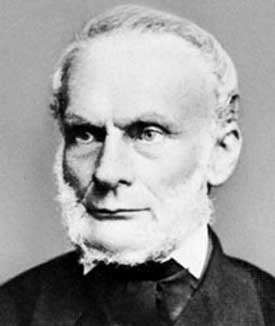<Back to Index>
- Physicist Rudolf Julius Emanuel Clausius, 1822
- Composer Mily Alexeyevich Balakirev, 1837
- Major General of the British Army James Wolfe, 1727
PAGE SPONSOR

Rudolf Julius Emanuel Clausius (Born Rudolf Gottlieb, 2 January 1822 – 24 August 1888), was a German physicist and mathematician and is considered one of the central founders of the science of thermodynamics. By his restatement of Sadi Carnot's principle known as the Carnot cycle, he put the theory of heat on a truer and sounder basis. His most important paper, On the mechanical theory of heat, published in 1850, first stated the basic ideas of the second law of thermodynamics. In 1865 he introduced the concept of entropy.
Clausius was born in Köslin (now Koszalin) in the Province of Pomerania. He started his education at the school of his father. After a few years, he went to the Gymnasium in Stettin (now Szczecin). Clausius graduated from the University of Berlin in 1844 where he studied Mathematics and Physics with, among others, Heinrich Magnus, Johann Dirichlet and Jakob Steiner. He also studied History with Leopold von Ranke. During 1847, he got his doctorate from the University of Halle on optical effects in the Earth's atmosphere. He then became professor of physics at the Royal Artillery and Engineering School in Berlin and Privatdozent at the Berlin University. In 1855 he became professor at the ETH Zürich, the Swiss Federal Institute of Technology in Zürich, where he stayed until 1867. During that year, he moved to Würzburg and two years later, in 1869 to Bonn.
In 1870 Clausius organized an ambulance corps in the Franco-Prussian War. He was wounded in battle, leaving him with a lasting disability. He was awarded the Iron Cross for his services. His wife, Adelheid Rimpham, died in childbirth in 1875, leaving him to raise their six children. He continued to teach, but had less time for research thereafter. In 1886 he remarried Sophie Stack, and then had another child.
Two years later, on 24 August 1888, he died in Bonn, Germany. Clausius'
PhD thesis concerning the refraction of light proposed that we see a
blue sky during the day, and various shades of red at sunrise and
sunset (among other phenomena) due to reflection and refraction of
light. Later, Lord Rayleigh would
show that it was in fact due to the scattering of light, but
regardless, Clausius used a far more mathematical approach than his
predecessors. His most famous paper, "Über die bewegende Kraft der Wärme" ("On the Moving Force of Heat and the Laws of Heat which may be Deduced Therefrom") was
published in 1850, and dealt with the mechanical theory of heat. In
this paper, he showed that there was a contradiction between Carnot's principle and the concept of conservation of energy. Clausius restated the two laws of thermodynamics to overcome this contradiction (the third law was developed by Walther Nernst, during the years 1906 – 1912). This paper made him famous among scientists. During 1857, Clausius contributed to the field of kinetic theory after refining August Krönig's
very simple gas-kinetic model to include translational, rotational and
vibrational molecular motions. In this same work he introduced the
concept of 'Mean free path' of a particle. Clausius deduced the Clausius-Clapeyron relation from thermodynamics. This relation, which is a way of characterizing the phase transition between two states of matter such as solid and liquid, had originally been developed in 1834 by Émile Clapeyron. In 1865, Clausius first gave a mathematical version of the concept of entropy, and gave it its name. He used the now abandoned unit 'Clausius' (symbol: Cl) for entropy. Clausius chose the word "entropy" because the meaning, from Greek, en+tropein, is "content transformative" or "transformation content" ("Verwandlungsinhalt").